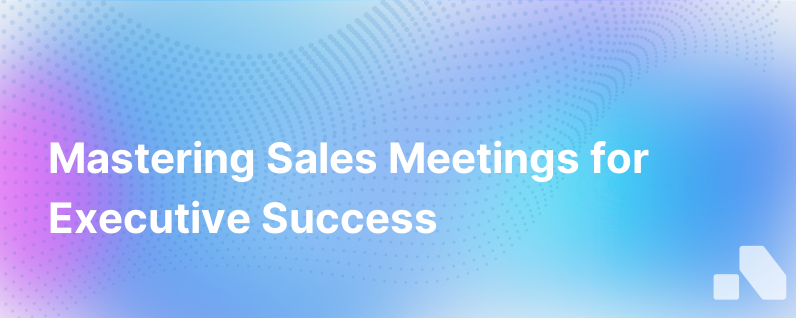
Sales meetings are a pivotal part of the sales process. They’re where you present your solution, handle objections, build rapport, and ultimately, they play a significant role in whether or not you close a deal. In a constantly evolving business landscape, having effective sales meetings is more crucial than ever. This comprehensive guide delves into making your sales meetings not just good, but great.
The Purpose of a Sales Meeting
Before we can improve our sales meetings, we must first understand their purpose. Primarily, they serve five critical functions:
- Discovery: Gathering information about the prospect’s needs, challenges, and business goals.
- Presentation: Showcasing your product’s features, benefits, and its potential impact on the prospect’s business.
- Objection handling: Addressing concerns and removing barriers to the sale.
- Rapport building: Establishing a relationship of trust and understanding with the prospect.
- Closing: Moving the prospect to the next step in the sales process, whether it involves signing a contract or scheduling a follow-up meeting.
Pre-Meeting Strategy
1. Research and Preparation You wouldn’t go into battle without a plan, and the same applies to sales meetings. Thoroughly research your prospect: their industry, company, role in the company, recent announcements, and any personal interests that you can use to build rapport.
2. Agenda Setting Clearly define the meeting agenda beforehand, and if possible, share it with the prospect. This sets expectations and demonstrates respect for their time.
3. Anticipate Questions Think ahead: What objections or questions might the prospect raise? How will you respond? Prepare and practice your responses so you're ready for whatever comes your way.
4. Use Account Intelligence Sales intelligence platforms like Aomni can help you strategically prepare for the meeting, offering real-time account research and competitive insights to tailor your approach.
Conducting the Meeting
1. Setting the Tone First impressions matter. Start the meeting on a positive note. Small talk can break the ice, but keep it brief and professional. Make sure every meeting participant introduces themselves to create a personal connection.
2. Discovery Phase This is your chance to learn as much about the prospect as possible. Ask open-ended questions that require more than a yes or no answer, and listen actively. The more you know about their needs, the better you can position your offering.
3. The Pitch Present your solution clearly, emphasizing how it addresses their specific pain points. Use stories and case studies to illustrate its impact and make it relatable. Where possible, showcase tangible results. Visual aids like slides or videos can help maintain engagement.
4. Handling Objections Handle objections with poise. Acknowledge the concern, clarify if necessary, and provide a thoughtful response. It’s important not to become defensive or dismissive.
5. Building Rapport Build rapport by demonstrating your understanding of their needs and by showing genuine interest. People buy from those they like and trust.
6. Closing the Conversation Summarize key points, agree on next steps, and set deadlines. Be clear about what each party is responsible for.
Post-Meeting Follow-Up
1. Prompt Follow-Up Send a follow-up email thanking them for their time, summarizing what was discussed, and outlining the agreed-upon next steps. Timeliness shows dedication and keeps the discussion top-of-mind.
2. Add Value Provide additional value in your follow-up. It could be an article relevant to the discussion, extra data to back up your claims, or answers to questions that were not addressed during the meeting.
3. Keep the Momentum Maintain a cadence of communication following the meeting. Check-in based on the prospect’s preferred schedule, not just when you want to move the sale forward.
Common Pitfalls to Avoid
- Poor Time Management: Respect the prospect’s time. Ensure meetings start and end on time.
- Lack of Customization: Avoid one-size-fits-all presentations. Tailor each meeting to the specific prospect.
- Information Overload: Don’t overwhelm with features and facts. Focus on relevant benefits.
- Talking More Than Listening: This meeting is about the prospect, not your product. Listen more than you speak.
Leveraging Technology
Modern sales teams have the advantage of technology. Sales enablement tools can help you streamline preparation and follow-up processes.
1. CRM Systems Customer Relationship Management (CRM) software can keep track of your interactions with prospects, ensuring you're always informed before going into a meeting.
2. Sales Intelligence Platforms Platforms like Aomni offer real-time insights that can bolster your sales meetings with personalized sales content and competitive insights, streamlining the preparation process and enhancing the relevance of your pitch.
3. Communication Tools Video conferencing tools, calendar scheduling apps, and email trackers can help manage the sales meeting process from start to finish.
Conclusion
Excellent sales meetings are a result of diligent preparation, engaging presentation, active listening, and purposeful follow-up. Avoiding the common pitfalls and making use of advancing technology can elevate your sales meetings from mundane to memorable.
In a world where every interaction can tip the scale towards a closed deal or a lost opportunity, being meticulous about your sales meetings is not just beneficial, it’s indispensable. Platforms like Aomni ensure that when you walk into a meeting, you are equipped with the latest, most relevant account intelligence, helping you to focus on what you do best—selling.